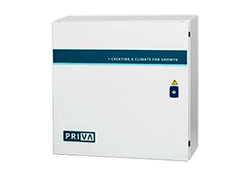Why You Need a Greenhouse Controller
Growing plants in a greenhouse offers many advantages, but one challenge remains—maintaining the perfect environment. Unlike outdoor gardening, a greenhouse allows you to control factors such as temperature, humidity, and light. However, managing these manually can be time-consuming and inefficient. This is where a greenhouse controller becomes invaluable.
A greenhouse controller acts like a central nervous system, automating key functions. It monitors environmental conditions inside the greenhouse and adjusts systems such as fans, heaters, and grow lights to maintain ideal growing conditions. By automating these processes, a greenhouse controller saves time and ensures consistency, which is critical for optimal plant health and yield.
Key Features of Greenhouse Controllers
There are several types of greenhouse controllers on the market, each offering different features. While choosing the right system for your greenhouse, consider the following key features:
Temperature Control
Temperature is one of the most important factors in plant growth. Too much heat can cause wilting, while cold temperatures can stunt growth or even kill plants. A good greenhouse controller will monitor the internal temperature and activate heaters or cooling systems to keep it within a desired range.
Humidity Regulation
Humidity control is crucial for many plants, as both high and low humidity levels can affect growth and the likelihood of diseases. A quality controller will not only monitor humidity levels but will also adjust ventilation and misters to maintain optimal conditions.
Lighting Management
Some plants need more light than others, and the amount of light they require can vary throughout the day or season. Many greenhouse controllers come with light sensors and controls that allow for the automatic adjustment of artificial grow lights, ensuring plants receive the right amount of light for healthy growth.
Ventilation
Good air circulation is essential for plant growth and preventing mold or mildew. Greenhouse controllers can be connected to fans and ventilation systems, automatically adjusting airflow based on the current temperature and humidity levels.
Irrigation Automation
Some advanced controllers include options for integrating irrigation systems, ensuring that plants receive consistent watering without human intervention. This feature is particularly helpful for commercial growers who need to manage large-scale greenhouse operations.
Remote Monitoring
Many modern greenhouse controllers come with smart technology that allows for remote monitoring and control through mobile apps. This means that even if you are away from your greenhouse, you can check on conditions and make adjustments as needed.
Benefits of Using a Greenhouse Controller
Efficiency
With a greenhouse controller in place, Greenhouse Fogging you can automate several aspects of your greenhouse management, which reduces labor costs and time. Automation allows you to run your greenhouse more efficiently, ensuring that plants receive the right conditions 24/7.
Consistency
Manual adjustments can result in inconsistent conditions, which can negatively affect plant growth. A controller ensures consistent, optimal conditions at all times, improving plant health and increasing yields.
Energy Savings
By automating heating, cooling, and lighting systems, a greenhouse controller can help you conserve energy. The system will only use energy when it’s needed, ensuring you don’t waste power on unnecessary heating or lighting.
Healthier Plants
The ability to maintain the perfect environment leads to healthier plants. With controlled temperature, humidity, and lighting, plants are less likely to experience stress, pests, or diseases.
Choosing the Right Greenhouse Controller
When selecting a greenhouse controller, consider the size of your greenhouse and the specific needs of the plants you are growing. You may want a system that offers remote access and smart features if you need to monitor multiple greenhouses or be alerted to any sudden changes in environmental conditions. It's also essential to choose a system that's easy to use and integrates well with your existing equipment.






Comments